Design Validation of UWB MIMO Antenna with Enhanced Isolation and Novel Strips for Stop-Band Characteristics
Abstract
1. Introduction
2. Design and Investigation of the Designed Antenna
3. Results and discussion
3.1. Reflection Coefficient and VSWR
3.2. Radiation Patterns, Radiation Efficiency, Total Efficiency and Peak Gain
3.3. Diversity Performances of the Presented Antenna
4. Conclusions
Author Contributions
Funding
Institutional Review Board Statement
Informed Consent Statement
Data Availability Statement
Conflicts of Interest
References
- Liang, C.; Su, R.; Gao, P.; Wang, P. Compact Printed MIMO Antenna with 6.1 GHz notched Band for ultra wide applications. Prog. Electromagn. Res. Lett. 2018, 76, 77–83. [Google Scholar] [CrossRef]
- Biswal, S.P.; Das, S. A compact printed ultra-wideband multiple-input multiple output prototype with band-notch ability for WiMAX, LTEband 43, and WLAN systems. Int. J. RF Microwave Comput. Aided Eng. 2019, 29, e21673. [Google Scholar] [CrossRef]
- Li, Z.; Yin, C.; Zhu, X. Compact UWB MIMO Vivaldi Antenna with Dual Band-Notched Characteristics. IEEE Access. 2019, 7, 38696–38701. [Google Scholar] [CrossRef]
- Li, W.; Hei, Y.; Grubb, P.M.; Shi, X.; Chen, R.T. Compact Inkjet-Printed Flexible MIMO Antenna for UWB Applications. IEEE Access. 2018, 6, 50290–50298. [Google Scholar] [CrossRef]
- Mathur, R.; Dwari, S. A compact UWB-MIMO with dual grounded CRR for isolation improvement. Int. J. RF Microwave Comput. Aided Eng. 2019, 29, e21500. [Google Scholar] [CrossRef]
- Chandel, R.; Gautam, A.K. Compact MIMO/diversity slot antenna for UWB applications with band-notched characteristic. Electron. Lett. 2016, 52, 336–338. [Google Scholar] [CrossRef]
- Khan, M.I.; Khattak, M.I.; Rahman, S.U.; Qazi, A.B.; Telba, A.A.; Sebak, A. Design and Investigation of Modern UWB-MIMO Antenna with Optimized Isolation. Micromachines 2020, 11, 432. [Google Scholar] [CrossRef] [PubMed]
- Sarkar, D.; Sarkar, K.; Saurav, K. A compact microstrip–fed triple band–notched UWB monopole antenna. IEEE Antennas Wirel. Propag. Lett. 2014, 13, 396–399. [Google Scholar] [CrossRef]
- Li, W.T.; Hei, Y.Q.; Subbaraman, H.; Shi, X.W.; Chen, R.T. Novel printed filtenna with dual notches and good out-of-band characteristics for UWB-MIMO applications. IEEE Microwave Wirel. Compon. Lett. 2016, 26, 765–767. [Google Scholar] [CrossRef]
- Li, J.F.; Wu, D.L.; Wu, Y.J. Dual Band-notched UWB MIMO Antenna with Uniform Rejection Performance. Prog. Electromagn. Res. M 2017, 54, 103–111. [Google Scholar] [CrossRef][Green Version]
- Bhattacharya, A.; Roy, B.; Chowdhury, S.K.; Bhattacharjee, A.K. An Isolation Enhanced, Printed, Low-Profile UWB-MIMO Antenna with Unique Dual Band-Notching Features for WLAN and WiMAX. IETE J. Res. 2019, 68, 1612284. [Google Scholar] [CrossRef]
- Khan, M.I.; Khattak, M.I. Designing and analyzing a modern MIMO-UWB antenna with a novel stub for stop band characteristics and reduced mutual coupling. Microwave Opt. Technol. Lett. 2020, 62, 3209–3214. [Google Scholar] [CrossRef]
- Suriya, I.; Anbazhagan, R. Inverted-A based UWB MIMO antenna with triple band notch and improved isolation for WBAN applications. Int. J. Electron. Commun. 2019, 99, 25–33. [Google Scholar] [CrossRef]
- Tang, Z.; Zhan, J.; Wu, X.; Xi, Z.; Chen, L.; Hu, S. Design of a compact UWB-MIMO antenna with high isolation and dual band-notched characteristics. J. Electromagn. Waves App. 2020, 34, 500–513. [Google Scholar] [CrossRef]
- Banerjee, J.; Karmakar, A.; Ghatak, R.; Poddar, D.R. Compact CPW-fed UWB MIMO antenna with a novel modified Minkowski fractal defected ground structure (DGS) for high isolation and triple band-notch characteristic. J. Electromagn. Waves App. 2017, 31, 1550–1565. [Google Scholar] [CrossRef]
- Thakur, E.; Jaglan, N.; Gupta, S.D. Design of compact triple band-notched UWB MIMO antenna with TVC-EBG structure. J. Electromagn. Waves Appl. 2020, 34, 1601–1615. [Google Scholar] [CrossRef]
- Biswal, S.P.; Das, S. A low profile dual port UWB-MIMO/diversity antenna with band rejection ability. Int. J. RF Microwave Comput. Aided Eng. 2018, 28, e21159. [Google Scholar] [CrossRef]
- Sampath, R.; Selvan, K.T. Compact hybrid Sierpinski Koch fractal UWB MIMO antenna with pattern diversity. Int. J. RF Microwave Comput. Aided Eng. 2020, 30, e22017. [Google Scholar] [CrossRef]
- Masoodi, I.S.; Ishteyaq, I.; Muzaffar, K.; Magray, M.I. A compact band notched antenna with high isolation for UWB MIMO applications. Int. J. Microwave Wirel. Technol. 2020, 13, 634–640. [Google Scholar] [CrossRef]
- Liu, G.; Liu, Y.; Gong, S. Compact uniplanar UWB MIMO antenna with band-notched characteristic. Microwave Opt. Technol. Lett. 2017, 59, 2207–2212. [Google Scholar] [CrossRef]
- Vyas, K.; Yadav, R.P. Planar suspended line technique based UWB-MIMO antenna having dual-band notching characteristics. Int. J. Microwave Wirel. Technol. 2020, 13, 614–623. [Google Scholar] [CrossRef]
- Banerjee, J.; Gorai, A.; Ghatak, R. Design and analysis of a compact UWB MIMO antenna incorporating fractal inspired isolation improvement and band rejection structures. Int. J. Electron. Commun. 2020, 122, 153274. [Google Scholar] [CrossRef]
- Deng, H.L.; Zhang, F.S.; Xie, G.J.; Zhang, H.; Zhao, Y. Design of a miniaturized UWB MIMO Vivaldi antenna with dual band- rejected performance. IEICE Electron. Express 2020, 17, 1–6. [Google Scholar]
- Azram, B.; Nourinia, J.; Ghobadi, C.; Majidzadeh, M. Highly isolated dual band stop two-element UWB MIMO antenna topology for wireless communication applications. J. Instrum. 2019, 14, P10036. [Google Scholar] [CrossRef]
- Azram, B.; Nourinia, J.; Ghobadi, C.; Majidzadeh, M.; Hatami, N. On development of a MIMO antenna for coupling reduction and WiMAX suppression purposes. Int. J. Electron. Commun. 2019, 99, 226–235. [Google Scholar] [CrossRef]
- Irene, G.; Rajesh, A. A dual-polarized UWB–MIMO antenna with IEEE 802.11ac band-notched characteristics using split-ring resonator. J. Comput. Electron. 2018, 17, 1090–1098. [Google Scholar] [CrossRef]
- Hatami, N.; Nourinia, J.; Ghobadi, C.; Majidzadeh, M.; Azram, B. High inter-element isolation and WLAN filtering mechanism: A compact MIMO antenna scheme. Int. J. Electron. Commun. 2019, 109, 43–54. [Google Scholar] [CrossRef]
- Naser, S.; Dib, N. Design and Analysis of Super-Formula-Based UWB Monopole Antenna and its MIMO Configuration. Wirel. Pers. Commun. 2017, 94, 3389–3401. [Google Scholar] [CrossRef]
- Zhao, Y.; Zhang, F.S.; Cao, L.X.; Li, D.H. A Compact Dual Band-Notched MIMO Diversity Antenna for UWB Wireless Applications. Prog. Electromagn. Res. C 2019, 89, 161–169. [Google Scholar] [CrossRef]
- Devana, V.N.K.R.; Rao, A.M. A Novel Dual Band Notched MIMO UWB Antenna. Prog. Electromagn. Res. Lett. 2020, 93, 65–71. [Google Scholar] [CrossRef]
- Pannu, P.; Sharma, D.K. Miniaturize four-port UWB-MIMO antenna with tri-notched band characteristics. Microwave Opt. Technol. Lett. 2021, 63, 1489–1498. [Google Scholar] [CrossRef]
- Islam, M.T.; Mahmud, M.Z.; Misran, N.; Takada, J.; Cho, M. Microwave Breast Phantom Measurement System with Compact Side Slotted Directional Antenna. IEEE Access. 2017, 5, 5321–5330. [Google Scholar] [CrossRef]
- Talukder, M.S.; Samsuzzaman, M.; Islam, M.T.; Azim, R.; Mahmud, M.Z.; Islam, M.T. Compact ellipse shaped patch with ground slotted broadband monopole patch antenna for head imaging applications. Chin. J. Phys. 2021, 72, 310–326. [Google Scholar] [CrossRef]
- Chandel, R.; Gautam, A.K. Design and Packaging of an Eye-Shaped Multiple-Input–Multiple-Output Antenna with High Isolation for Wireless UWB Applications. IEEE Trans. Compon. Packag. Manuf. Technol. 2018, 8, 635–642. [Google Scholar] [CrossRef]
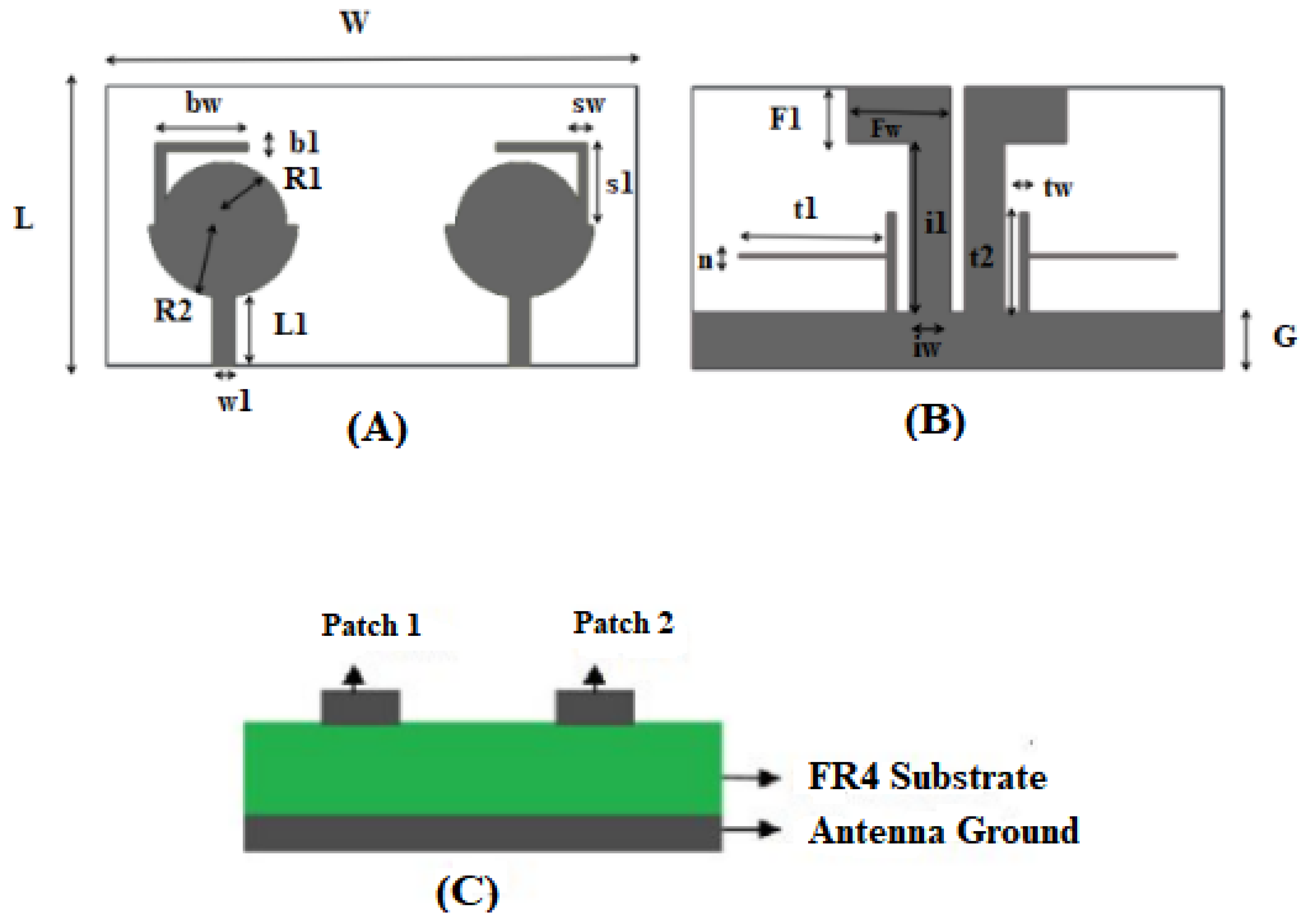
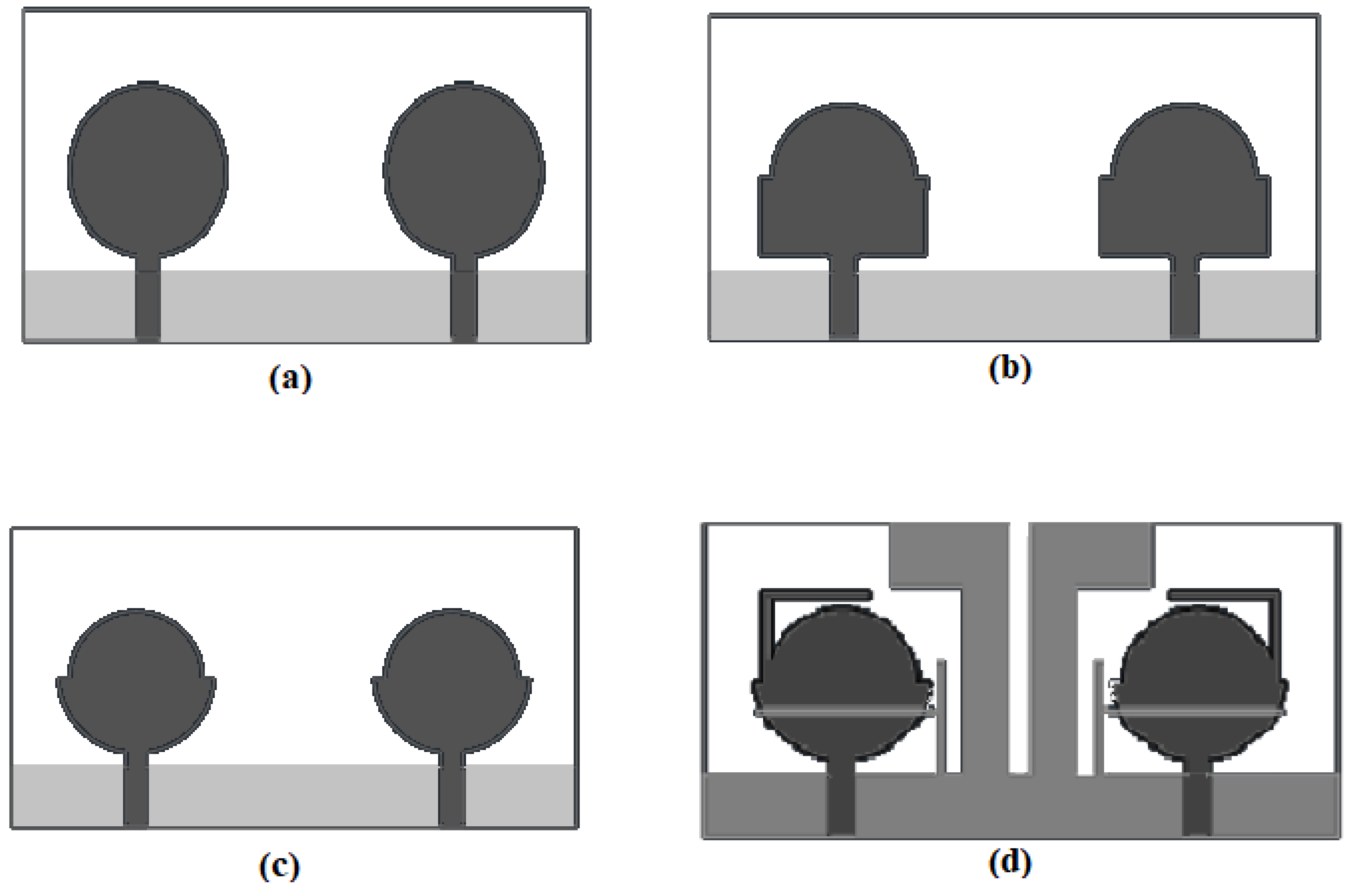
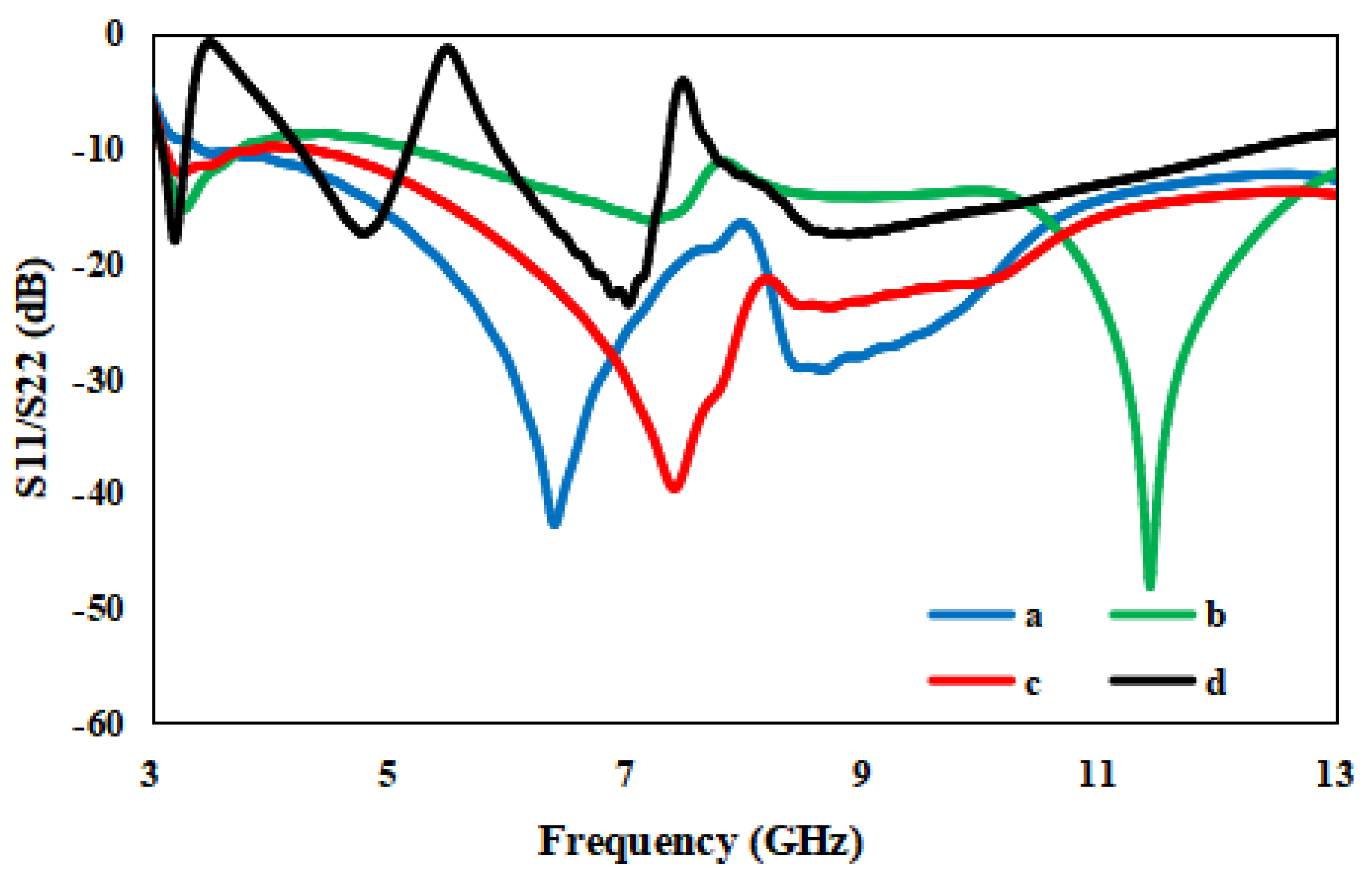
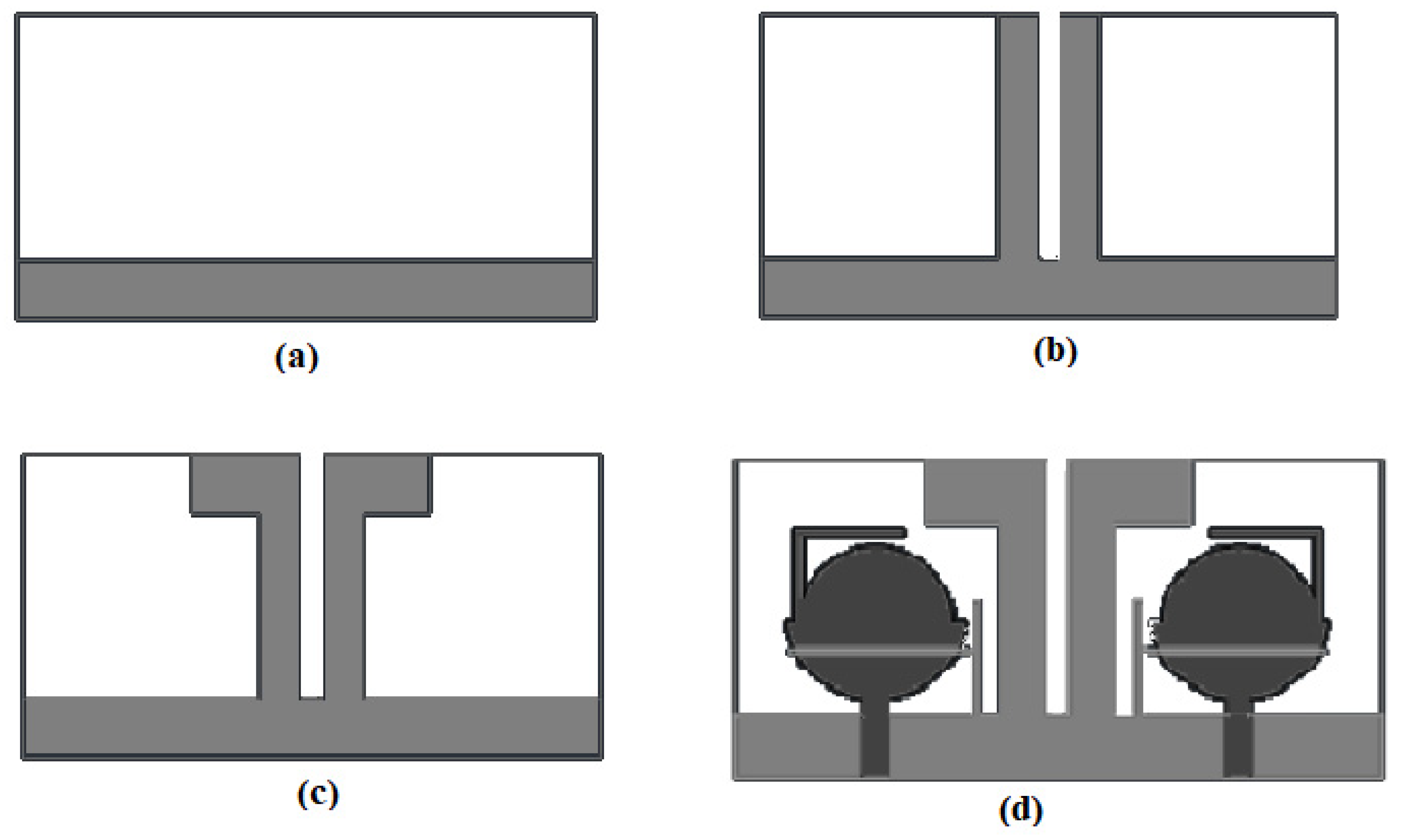
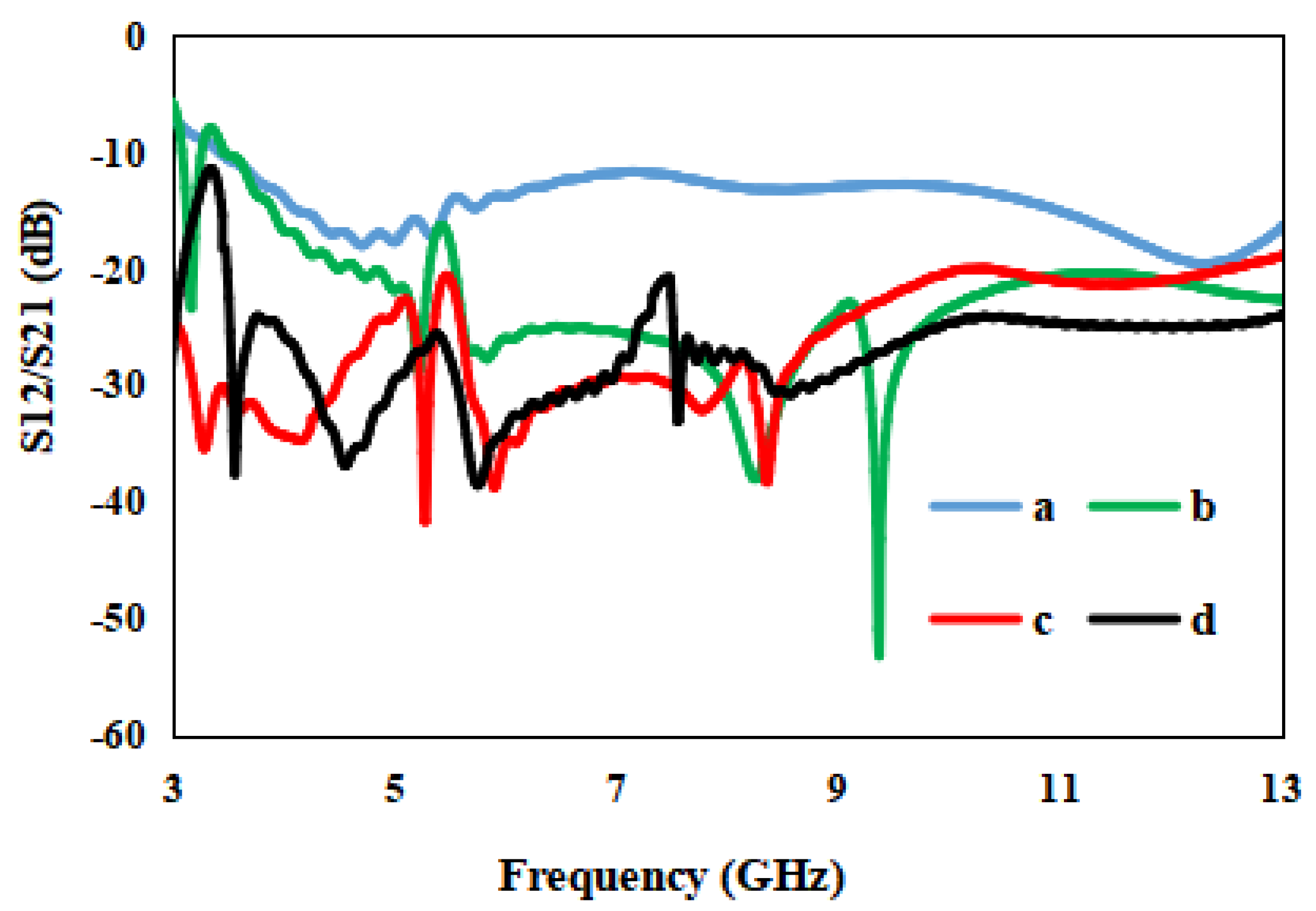
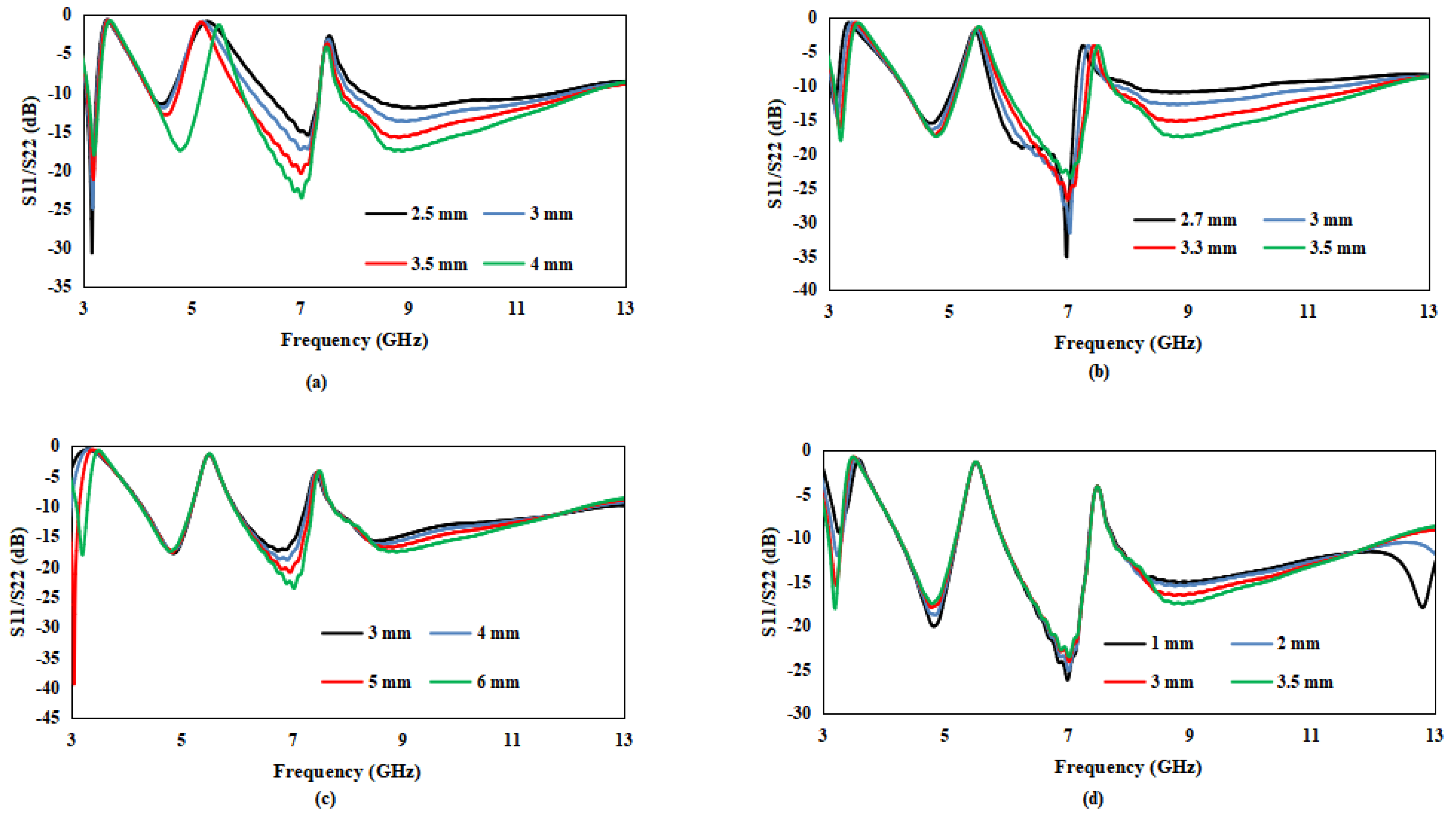



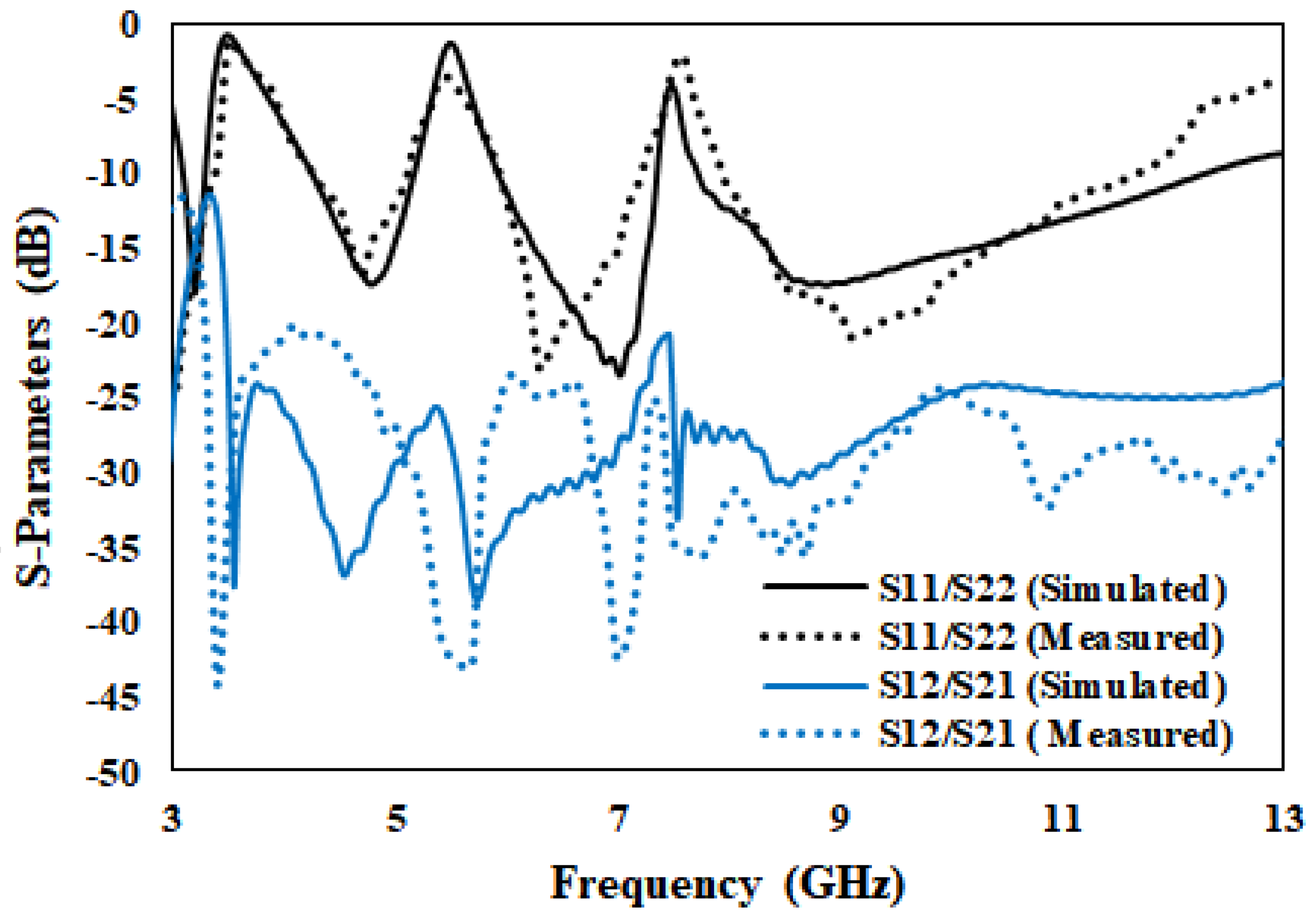
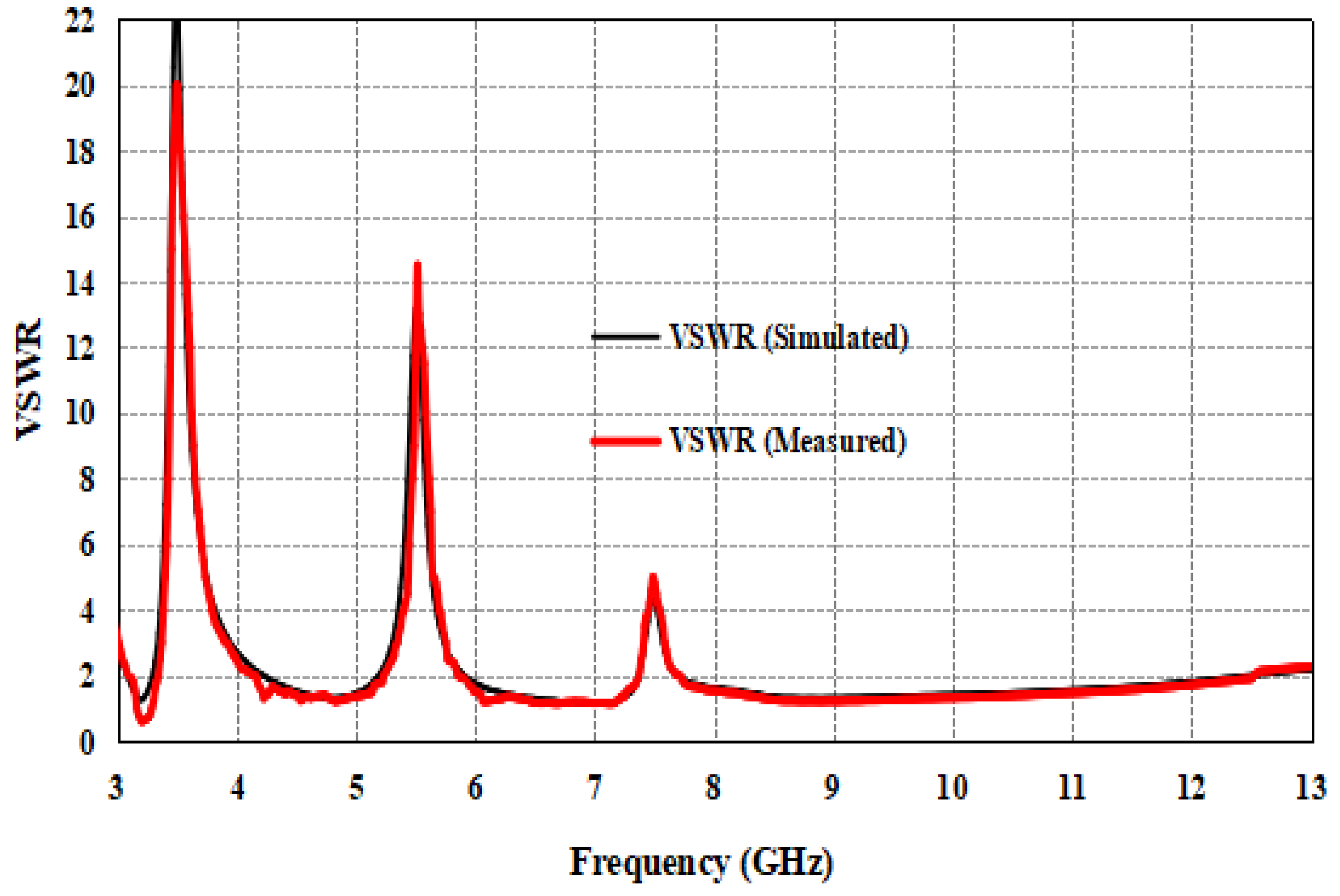
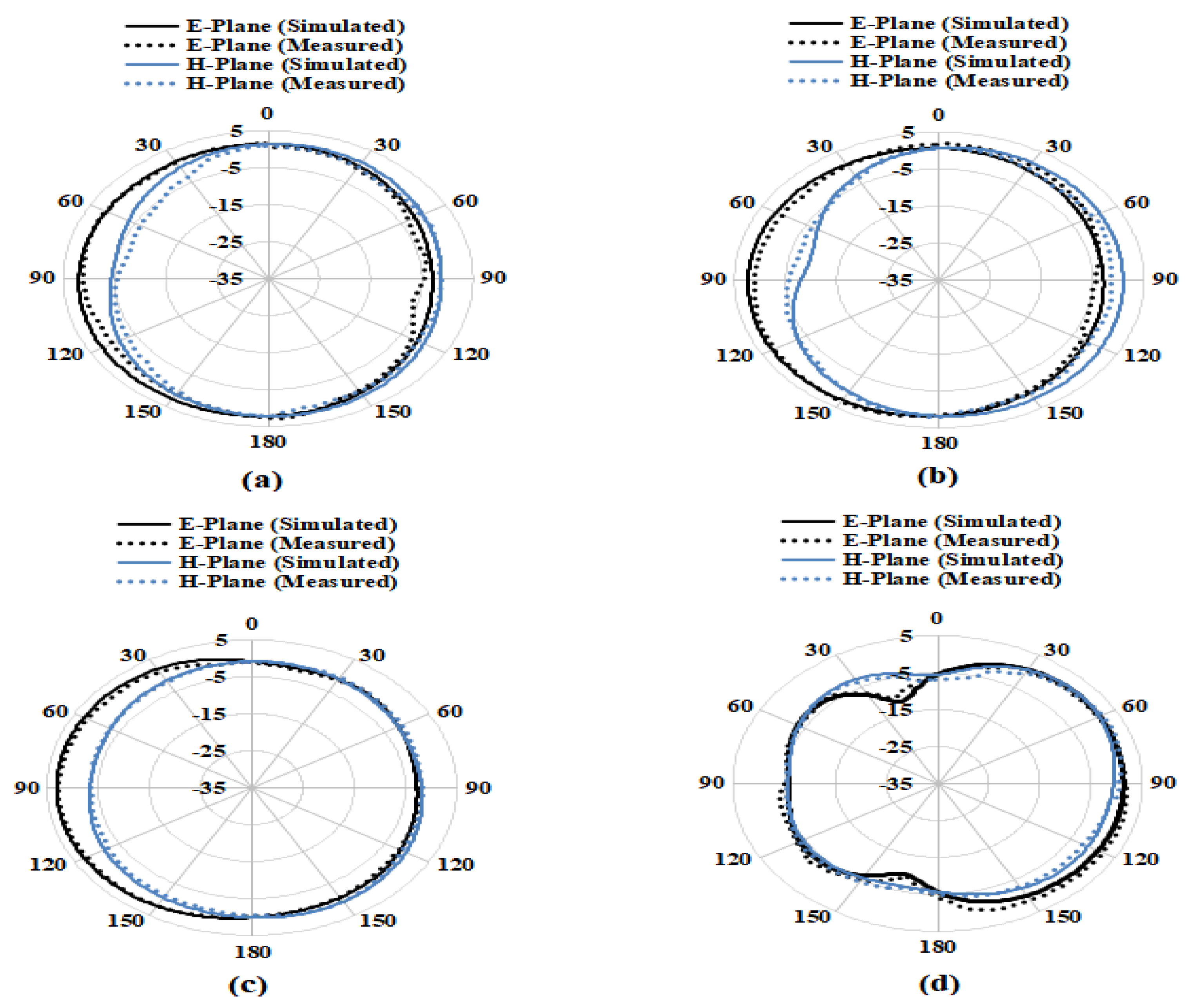
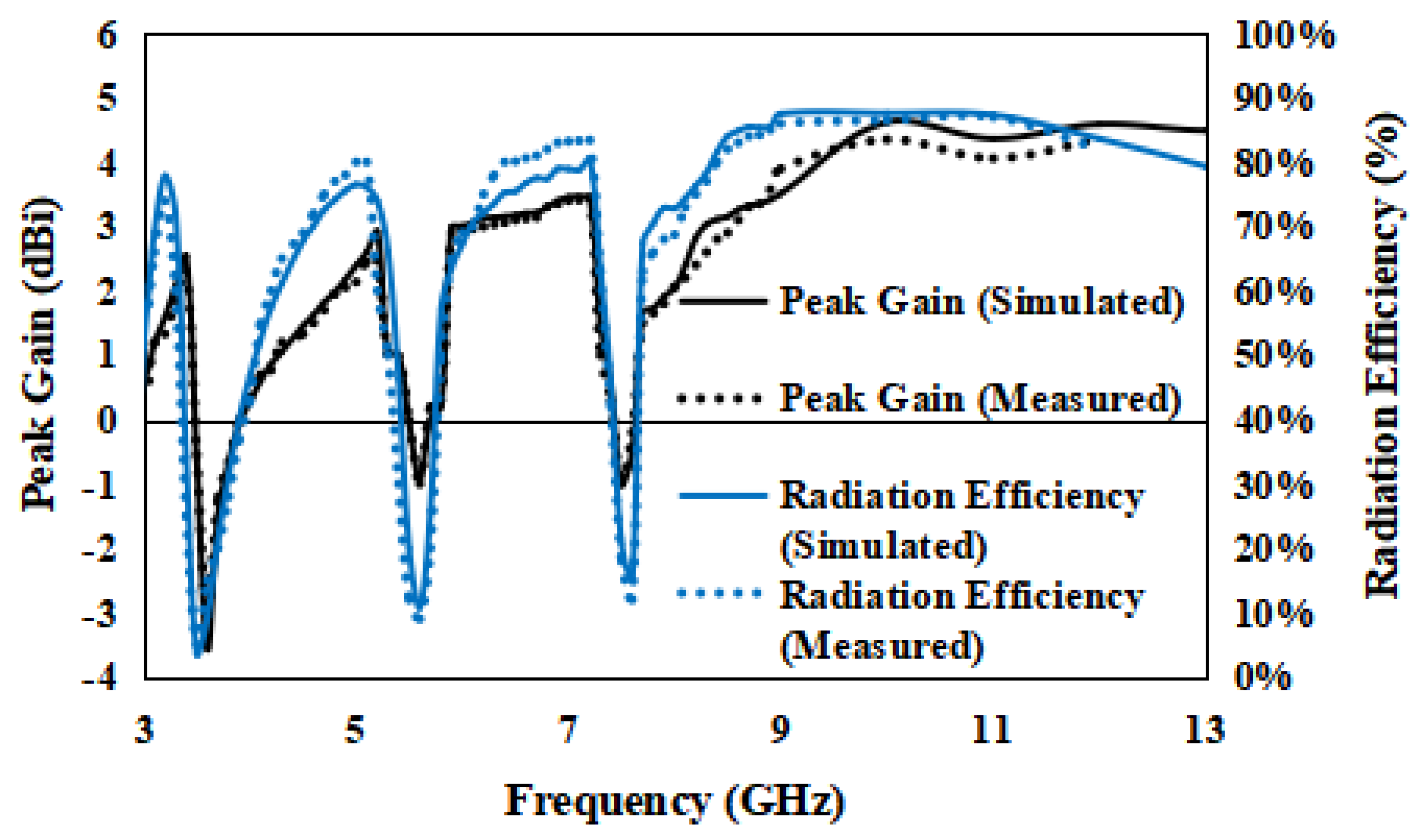
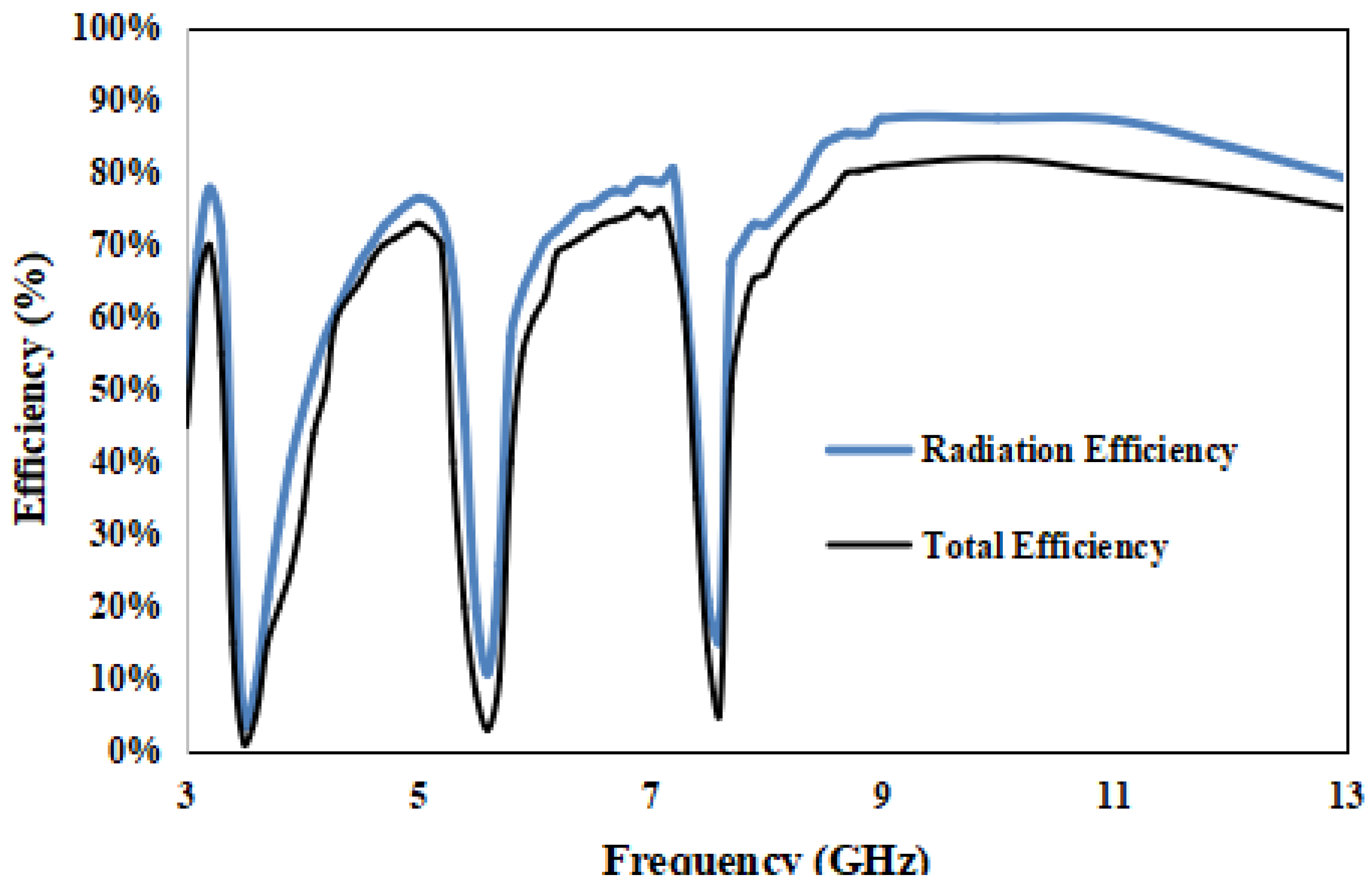
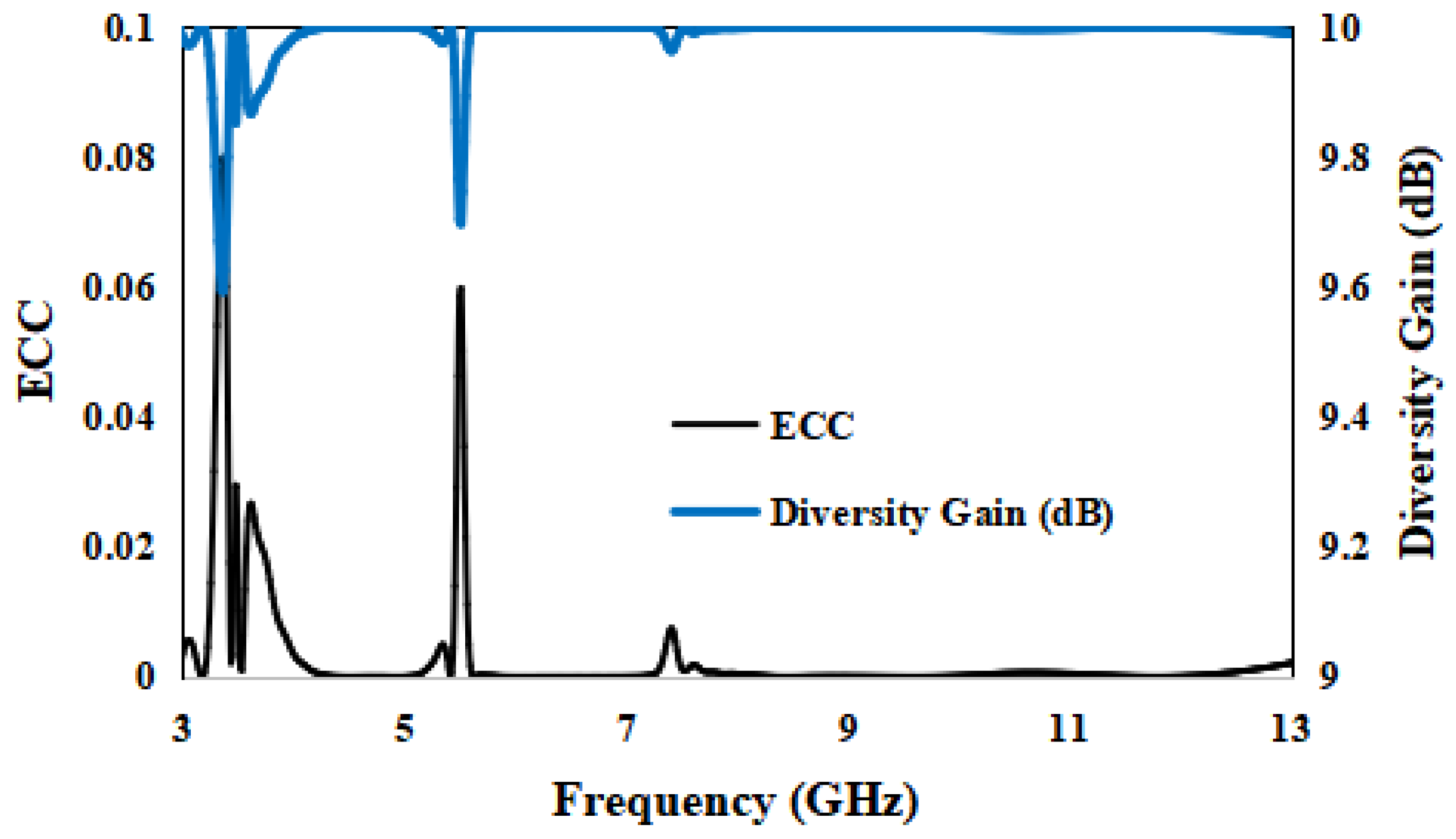
| Ref. | Size (mm2) | Bandwidth (GHz) | Band Notches (GHz) | Isolation (dB) | Gain (dBi) | ECC |
|---|---|---|---|---|---|---|
| [11] | 26 × 35 | 2–10.6 | 3.3–3.7, 5.17–5.25 | <22 | 3.5 | <0.2 |
| [12] | 18 × 36 | 3–11 | 3.25–3.75, 5–5.9 | <20 | −4–4 | 0.05 |
| [13] | 38.5 × 38.5 | 3.1–10.6 | 3.9–4.2, 5.1–5.85, | <17 | 0–6 | 0.035 |
| [14] | 25 × 39 | 2.82–11.2 | 5.08–5.83, 7.02–7.98 | <20 | 2–5 | 0.01 |
| [15] | 26.75 × 41.5 | 3.1–11.5 | 3.3–3.7, 3.7–4.2, 5.15–5.85 | <19 | - | 0.01 |
| [16] | 21 × 36 | 2–11 | 3.3–3.7, 5–6, 7.9–8.4 | <15 | 0–7 | 0.015 |
| [17] | 30 × 30 | 3.08–10.98 | 4.98–5.96 | <20 | 5 | <0.13 |
| [18] | 40 × 20 | 2.5–11 | 5–6 | <20 | 3 | <0.1 |
| [19] | 29 × 40 | 3.1–11 | 5.725–5.825 | <18 | 1.6–6.2 | <0.02 |
| [20] | 33 × 26 | 3.1–10.6 | 4.5–5.5 | <15 | 1–6 | 0.03 |
| [21] | 20 × 36 | 3.1–11.5 | 5.45–5.85, 7.15–7.95 | <21 | 1.8–3 | <0.19 |
| [22] | 30.75 × 37.80 | 2.7–11.22 | 3.7–4.2, 5.15–5.825, 7.9–8.4 | <20 | 0.07–3.4 | 0.035 |
| [23] | 26 × 24.5 | 2.5–12 | 5.1–5.9, 6.6–7.1 | <15 | …… | 0.02 |
| [29] | 26 × 28 | 2.9–10.8 | 5.15–5.86, 6.7–7.1 | <15 | 1.6–4 | 0.08 |
| [30] | 40 × 22 | 3.18–11.26 | 3.3–3.99, 4.97–5.93 | <15 | 0–5.4 | 0.002 |
| Proposed work | 18 × 34 | 3.07–12.40 | 3.28–4.20, 5.18–5.92, 7.35–7.76 | <22 | 1.6–4.6 | <0.001 |
| Parameters | Size (mm) | Parameters | Size (mm) |
|---|---|---|---|
| L | 18 | G | 3.5 |
| W | 34 | R1 | 4 |
| R2 | 4.7 | L1 | 4.74 |
| w1 | 1.3 | s1 | 5 |
| sw | 0.5 | b1 | 0.5 |
| bw | 4.8 | i1 | 11 |
| iw | 2.5 | F1 | 3.5 |
| Fw | 6.5 | t2 | 6.5 |
| tw | 0.5 | t1 | 10 |
Publisher’s Note: MDPI stays neutral with regard to jurisdictional claims in published maps and institutional affiliations. |
© 2022 by the authors. Licensee MDPI, Basel, Switzerland. This article is an open access article distributed under the terms and conditions of the Creative Commons Attribution (CC BY) license (https://creativecommons.org/licenses/by/4.0/).
Share and Cite
Khan, M.K.; Feng, Q. Design Validation of UWB MIMO Antenna with Enhanced Isolation and Novel Strips for Stop-Band Characteristics. Entropy 2022, 24, 766. https://doi.org/10.3390/e24060766
Khan MK, Feng Q. Design Validation of UWB MIMO Antenna with Enhanced Isolation and Novel Strips for Stop-Band Characteristics. Entropy. 2022; 24(6):766. https://doi.org/10.3390/e24060766
Chicago/Turabian StyleKhan, Muhammad Kabir, and Quanyuan Feng. 2022. "Design Validation of UWB MIMO Antenna with Enhanced Isolation and Novel Strips for Stop-Band Characteristics" Entropy 24, no. 6: 766. https://doi.org/10.3390/e24060766
APA StyleKhan, M. K., & Feng, Q. (2022). Design Validation of UWB MIMO Antenna with Enhanced Isolation and Novel Strips for Stop-Band Characteristics. Entropy, 24(6), 766. https://doi.org/10.3390/e24060766






